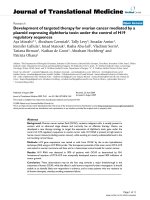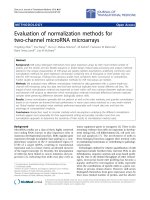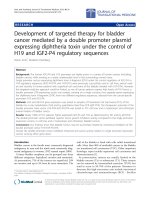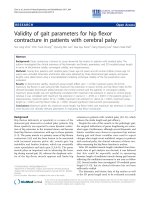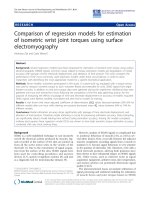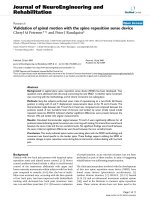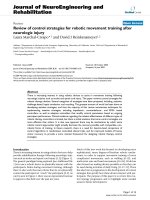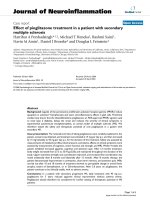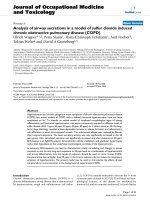Báo cáo hóa học: " Optimization of capsid-incorporated antigens for a novel adenovirus vaccine approach" doc
Bạn đang xem bản rút gọn của tài liệu. Xem và tải ngay bản đầy đủ của tài liệu tại đây (418.58 KB, 13 trang )
BioMed Central
Page 1 of 13
(page number not for citation purposes)
Virology Journal
Open Access
Research
Optimization of capsid-incorporated antigens for a novel
adenovirus vaccine approach
Qiana L Matthews
1
, PingAr Yang
2
, Qi Wu
2
, Natalya Belousova
3
,
Angel A Rivera
1
, Mariam A Stoff-Khalili
4
, Reinhard Waehler
1
, Hui-
Chen Hsu
2
, Zan Li
5
, Jing Li
1
, John D Mountz
2,6
, Hongju Wu
1
and
David T Curiel*
1
Address:
1
Division of Human Gene Therapy, Departments of Medicine, Pathology, Surgery, Obstetrics and Gynecology, and the Gene Therapy
Center, University of Alabama at Birmingham, Birmingham, USA,
2
Division of Clinical Immunology and Rheumatology, Department of
Medicine, University of Alabama at Birmingham, Birmingham, USA,
3
Department of Experimental Diagnostic Imaging, MD Anderson Cancer
Center, University of Texas, Houston, USA,
4
Department of Obstetrics and Gynecology, University of Duesseldorf, Medical Center, Duesseldorf,
Germany,
5
Alabama School of Fine Arts, Birmingham, USA and
6
Birmingham VA Medical Center, Birmingham, USA
Email: Qiana L Matthews - ; PingAr Yang - ; Qi Wu - ;
Natalya Belousova - ; Angel A Rivera - ; Mariam A Stoff-Khalili - mariam.stoff-
; Reinhard Waehler - ; Hui-Chen Hsu - ; Zan Li - ;
Jing Li - ; John D Mountz - ; Hongju Wu - ; David T Curiel* -
* Corresponding author
Abstract
Despite the many potential advantages of Ad vectors for vaccine application, the full utility of
current Ad vaccines may be limited by the host anti-vector immune response. Direct incorporation
of antigens into the adenovirus capsid offers a new and exciting approach for vaccination strategies;
this strategy exploits the inherent antigenicity of the Ad vector. Critical to exploiting Ad in this new
context is the placement of antigenic epitopes within the major Ad capsid protein, hexon. In our
current study we illustrate that we have the capability to place a range of antigenic epitopes within
Ad5 capsid protein hexon hypervariable regions (HVRs) 2 or 5, thus producing viable Ad virions.
Our data define the maximal incorporation size at HVR2 or HVR5 as it relates to identical antigenic
epitopes. In addition, this data suggests that Ad5 HVR5 is more permissive to a range of insertions.
Most importantly, repeated administration of our hexon-modified viruses resulted in a secondary
anti-antigen response, whereas minimal secondary effect was present after administration of Ad5
control. Our study describes antigen placement and optimization within the context of the capsid
incorporation approach of Ad vaccine employment, thereby broadening this new methodology.
Introduction
Adenoviruses (Ad) have recently been employed for a
wide range of vaccination strategies [1]. In this regard, a
number of practical advantages are recognized in using
Ad-based vectors for antigen gene delivery. These advan-
tages include the ease of manipulation of the viral
genome, the ability to prepare high titer stocks of recom-
binant virions, and the ability of the vector to infect a wide
array of target cells [2-4] relevant to the achievement of a
useful vaccine effect. These considerations highlight the
Published: 21 August 2008
Virology Journal 2008, 5:98 doi:10.1186/1743-422X-5-98
Received: 19 June 2008
Accepted: 21 August 2008
This article is available from: />© 2008 Matthews et al; licensee BioMed Central Ltd.
This is an Open Access article distributed under the terms of the Creative Commons Attribution License ( />),
which permits unrestricted use, distribution, and reproduction in any medium, provided the original work is properly cited.
Virology Journal 2008, 5:98 />Page 2 of 13
(page number not for citation purposes)
emerging recognition that Ad vectors embody enormous
promise for the realization of diverse vaccine interven-
tions. Of note, Ad-based vaccinations have been practi-
cally translated for human applications and have
progressed in a variety of immunization contexts such as
cancer and infectious diseases [5-12].
Currently, new methods to exploit Ad for vaccine pur-
poses have been developed. These recent approaches have
utilized the natural mechanisms of Ad virion immuno-
genicity whereby antigen epitopes can be directly incorpo-
rated into the viral capsid as the basis by which immune
presentation of the epitope is achieved [10,13-16]. Strate-
gies advancing this "capsid incorporation" paradigm have
evaluated a range of virion capsid proteins as well as a
variety of antigens, model and pathogenic [10,14-17].
The major capsid protein hexon has been the focus of the
majority of these capsid incorporation strategies owing to
its natural role in the generation of anti-Ad immune
response and its numerical representation vis a via the vir-
ion's structural organization [14,18]. Using this strategy,
we have developed the means to incorporate heterolo-
gous peptide epitopes specifically within the major sur-
face-exposed domains of the Ad capsid protein hexon
[18]. Of note, our previous studies have show that we can
incorporate small heterologous peptides into Ad hexon
hypervariable regions (HVRs) without perturbing viral
viability and major biological characteristics such as repli-
cation, thermostability, or native infectivity [18]. Other
published studies have focused on incorporations at
HVR5 or single site incorporations [17]. However, it has
been recognized that the ability to place antigen within
multiple sites of the hexon capsid protein holds impor-
tant potential for presenting multiple epitopes/antigens
or several copies of the same epitope within a single Ad
vector-based vaccine.
In this regard, capsid surface localization of HVR sites
derived from X-ray crystallography suggests that both
HVR2 and HVR5 loci are potentially useful for capsid
incorporation of antigens for vaccination. As noted, there
have been recent reports in which HVR5 has been
exploited with respect to epitope insertion [10,14,15,18-
21]. Based on our abilities to manipulate both HVR2 and
HVR5 sites, we sought to explore the relative merits of
these two hexon locales. To compare the flexibility and
capacities of HVR2 and HVR5, respectively we genetically
incorporated identical epitopes of incrementally increas-
ing size within HVR2 or HVR5 of Ad5 hexon. Our study
illustrates that hexon incorporated model antigens elicit a
varied immune response in the context of antigen place-
ment or antigen size at both the HVR2 or HVR5 locales.
Materials and methods
Antibodies
Mouse anti-penta-His
6
tag monoclonal antibody (34660)
was purchased from Qiagen (Valencia, CA). Horse radish
peroxidase (HRP)-conjugated goat anti-mouse secondary
antibodies were purchased from DakoCytomation (Den-
mark).
Cell culture
Human embryonic kidney cells (293) were obtained from
and cultured in the medium recommended by the Ameri-
can Type Culture Collection (Manassas, VA). All cell lines
were incubated at 37°C and 5% CO
2
under humidified
conditions.
Recombinant adenovirus construction
In order to generate recombinant adenoviruses with
hexon insertions of arginine-glycine-aspartic acid (RGD)-
containing sequences, fragments of the Ad5 penton base
gene corresponding to the RGD motifs were derived by
PCR and cloned into the BamHI site in the previously
described HVR2-His
6
/pH5S or HVR5-His
6
/pH5S plas-
mids [18]. The sequences corresponding to penton base-
derived peptides, 33RGD, 43RGD, 53RGD, 63RGD,
73RGD, and 83RGD, were PCR amplified from Ad5
genomic DNA with the following pairs of primers: 33RGD
sense (s) and 33RGD anti-sense (as), 43RGD sense (s)
and 43RGD anti-sense (as), 53RGD sense (s) and 53RGD
anti-sense (as), 63RGD sense (s) and 63RGD anti-sense
(as), 73RGD sense (s) and 73RGD anti-sense (as), and
83RGD sense (s) and 83RGD anti-sense (as) (Table 1).
For additional details, see reference [22]. To create Ad5
Table 1: Primers used in this study.
33RGD -(as) CGGGATCCTGCTTCGGCCTCAGCGCGC
33RGD -(s) CGGGATCCGCCGCGGCAATGCAGCC
43RGD -(as) CGGGATCCGGCAGCTTCGGCCGCTG
43RGD -(a) CGGGATCCAACTCCAACGCGGCAGCC
53RGD -(as) CGGGATCCTTGCGCAGCGGGGGC
53RGD -(a) CGGGATCCAGCGGCGCGGAAGAGAACTC
63RGD -(as) CGGGATCCCTTCTCGACCTCGGGTTGCG
63RGD -(a) CGGGATCCAGCAACAGCAGTGGCAGCG
73RGD -(as) CGGGATCCCGGTTTCTTCTGAGGCTTCTCG
73RGD -(a) CGGGATCCGGTGGCGCAGGCGG
83RGD -(as) CGGGATCCCAGGGGTTTGATCACCGGTTT
83RGD -(a) CGGGATCCACCGAACAGGGCGGGG
3'HVR5-(as) GGCATGTAAGAAATATGAGTGTCTGGG
5'HVR2-(s) CTCACGTATTTGGGCAGGCGCC
a
antisense, as; sense, s.
b
Underlined letters represent the sequences
encoding the RGD motifs.
Virology Journal 2008, 5:98 />Page 3 of 13
(page number not for citation purposes)
vectors containing RGD epitopes in the HVRs of hexon,
these resulting plasmids were digested with EcoRI and
PmeI. These resulting fragments containing the homolo-
gous recombination regions and the hexon genes were
purified, then recombined with a SwaI-digested Ad5 back-
bone vector that lacks the hexon gene, pAd5/ΔH5 [23].
These recombination reactions were performed in
Escherichia coli BJ5183 (Strategene, La Jolla, CA). The
resultant clones were designated Ad5/HVR2-33RGD-His
6
,
Ad5/HVR5-33RGD-His
6
, Ad5/HVR5-43RGD-His
6
, and
Ad5/HVR5-53RGD-His
6
, all of which contain the green
fluorescence protein gene and firefly luciferase gene in the
E1 region [18]. The constructs were confirmed by restric-
tion enzyme digestions and sequence analysis. Ad5, Ad5/
HVR2-His
6
, and Ad5/HVR5-His
6
were previously con-
structed as described [18].
Virus rescue and preparation
To rescue viruses, the constructed plasmids were digested
with PacI, and 2 μg DNA were transfected (Lipofectamine
2000 Reagent, Invitrogen, Carlsbad, CA) into the Ad-E1-
expressing 293 cells. After plaques formed, they were
processed for large-scale proliferation in 293 cells. Viruses
were purified by double cesium chloride ultracentrifuga-
tion and dialyzed against phosphate-buffered saline con-
taining 10% glycerol. Viruses were stored at -80°C until
use. Final aliquots of virus were analyzed for physical titer
using absorbance at 260 nm. The infectious viral titer
(infectious particles per ml) was determined by tissue cul-
ture infectious dose (TCID
50
) assay. Modifications of the
hexon gene was confirmed by PCR analysis with the prim-
ers 5'HVR2 (s), CTCACGTATTTGGGCAGGCGCC and
3'HVR5(as), GGCATGTAAGAAATATGAGTGTCTGGG,
which anneal up and downstream of the site of the inser-
tion within the hexon open reading frame (Table 1).
Whole virus ELISA and sera ELISA
The enzyme-linked immunosorbent assay (ELISA) assay
was performed essentially as described previously [24]. In
brief, different amounts of viruses ranging from 4 × 10
6
to
9 × 10
9
VPs were immobilized in wells of a 96-well plate
(Nunc Maxisorp, Rochester, NY) by overnight incubation
in (per well) 100 μl of 100 mM carbonate buffer (pH 9.5)
at 4°C. After washing with 0.05% Tween 20 in Tris-buff-
ered saline and blocking with blocking solution (2%
bovine serum albumin and 0.05% Tween 20 in TBS), the
immobilized viruses were incubated with anti-penta-His
6
tag monoclonal antibody (Qiagen, Valencia, CA) for 2 h
at room temperature, followed by AP-conjugated goat
anti-mouse antibody incubation. Colormetric reaction
was performed with p-nitrophenyl phosphate (Sigma-
Aldrich, St. Louis, MO) as recommended by the manufac-
turer, and optical density at 450–650 nm (OD
450–650
) was
obtained with a microplate reader (Molecular Devices).
For the anti-RGD33-His
6
and anti-His
6
response, ELISA
plates (Nunc Maxisorp, Rochester, NY) were coated with
20 μM of the RGD33-His
6
peptide or the His
6
peptide in
100 μl of 50 mM carbonate (pH 9.6) per well according to
the method we described previously [25]. Plates were
washed and then blocked with 3% BSA/PBS. After wash-
ing, 60 μl of 1:50 diluted sera was added. After incubation
for at least 2 hr at RT, the plates were extensively washed,
and the isotype-specific HRP-conjugated anti-mouse anti-
body (Southern Biotech., Birmingham, AL) was added.
ELISAs were developed with TMB substrate (Sigma-
Aldrich, St. Louis, MO). OD
450–650
was measured on an
Emax microplate reader.
Mouse immunization
Female C57BL/6J (H-2
b
) mice at 6–8 weeks of age were
obtained from the Jackson Laboratory (Bar Harbor, ME).
Groups of at least three to five mice were analyzed in each
experiment or at each time point. For antibody response
analysis, the following adenoviral vectors were injected
into each group of mice: Ad5, Ad5/HVR2-His
6
, Ad5/
HVR5-His
6
, Ad5/HVR2-33RGD-His
6
, Ad5/HVR5-33RGD-
His
6
, Ad5/HVR5-43RGD-His
6
, and Ad5/HVR5-53RGD-
His
6
at 1 × 10
10
viral particles (VPs) per mouse using tail
intravenous injection. For CD4
+
T cell response analysis,
the following adenoviral vectors were injected to each
group of mice: Ad5, Ad5/HVR2-33RGD-His
6
, or Ad5/
HVR5-33RGD-His
6
at 1 × 10
10
VP per mouse using tail
intravenous injection. On day 40, these mice were intrave-
nously boosted with the same dose of the same vectors or
peptide. These mice were then sacrificed 9 days later. All
animal protocols were approved by the Institutional Ani-
mal Care and Use Committee at the University of Ala-
bama at Birmingham.
Peptide prediction and synthesis
The antigenic epitope of His
6
and RGD33-His
6
were pre-
dicted using the Emboss program rce
forge.net/apps/antigenic.html and by the Kyle-Doolittle
hydropathic plot from the FIMM database of functional
molecular immunology :8080/
fimm/. Peptide sequences that were given high binding
scores in both prediction programs were chosen for ELISA
analysis. Peptides were synthesized by GenScript Co (Pis-
cataway, NJ) and were >98% pure as indicated by analyti-
cal high-performance liquid chromatography. Peptides
were dissolved in 100% DMSO at a concentration of 10
mM and stored at -20°C until use.
Intracellular flow cytometry staining
Intracellular analysis of cytokines produced by CD4+ T
cells was carried out using FACS analysis according to the
protocol of Harrington, et al. and Mangan, et al.[26,27].
Briefly, prior to carrying out intracellular cytokine stain-
ing, polarized whole spleen cells or CD4+ T cells were
Virology Journal 2008, 5:98 />Page 4 of 13
(page number not for citation purposes)
stimulated for 5 h with phorbylmyristyl acetate (50 ng/
ml; Sigma-Aldrich, St. Louis, MO) and ionomycin (750
ng/ml; Sigma-Aldrich) in the presence of either GolgiStop
at the recommended concentrations (BD Pharmingen,
San Diego, CA). Cells were first stained extracellularly
with fluorescein isothiocyanate-conjugated anti-CD4+
(RM4-5), fixed and permeabilized with Cytofix/Cytoperm
solution (BD Pharmingen), and then stained intracellu-
larly with allophycocyanin-conjugated anti-IFN-γ
(XMG1.2) and anti-IL-4 (11B11). Samples were acquired
on a FACSCalibur (Becton Dickinson, Franklin Lakes, NJ)
and data were analyzed with FlowJo (Ashland, OR) soft-
ware.
Statistical evaluation
The data are presented as the mean ± the standard error.
Statistical analyses were performed with the nonpaired
two-tailed Student t test, assuming equal variance. Statis-
tical significance was defined as P < 0.05.
Results
Incorporation of antigenic epitopes within Ad5 hexon
HVR2 or HVR5
In order to assess the capacity of the Ad5 hexon hypervar-
iable regions to accommodate heterologous polypeptides,
we genetically incorporated incrementally increasing frag-
ments of the Arg-Gly-Asp (RGD)-containing loop of the
Ad5 penton base. Fragments were engineered to contain
the RGD motif in the middle, flanked by penton base-
derived sequences of equal lengths on both sides. The
length of each flanking sequence in the shortest construct
was 15 amino acid (aa) residues; this was increased by 10-
aa increments in succeeding constructs [22]. DNA
sequences corresponding to the fragments of the penton
base protein were assembled by PCR (Figure 1A. and
Table 1). These PCR products were cloned between
codons for Ser192 and His193 (Fig. 1B–1) of the previ-
ously modified Ad5/HVR2-His
6
genome [18] or between
codons for Ser273 and His274 of the previously modified
Ad5/HVR5-His
6
genome (Fig. 1B–2) [18]. A total of six
fragments encoding the penton base protein ranging in
size from 33, 43, 53, 63, 73, and 83 aa were amplified and
incorporated into the Ad5 hexon HVR2 or HVR5 region.
Ad5 hexon HVR2 or HVR5 can accommodate large
heterologous polypeptides
The newly designed hexon genes were transferred into the
E1-deleted Ad5 genome lacking the hexon gene. Subse-
quent transfection of 293 cells with the resultant recom-
binant genomes led to the rescue of 4 of the 12 vectors.
Viable viruses were produced with incorporation of 33 aa
plus a 12 aa linker at HVR2 or HVR5 (Table 2A). In addi-
tion, viable viruses were rescued with incorporations of 43
and 53 aa plus linkers at HVR5 (Table 2A). The recom-
binant hexon viruses rescued contained the aforemen-
tioned penton base-RGD composition (Table 2B).
Rescued viruses were further amplified and their identities
were confirmed by PCR, non-defective revertant viruses
were not detected (data not shown). These data were fur-
ther confirmed by partial sequencing of the hexon genes
contained in the Ad5/HVR2 or Ad5/HVR5 genomes. Hav-
ing established the identities of the newly rescued Ad
viruses, we next tested whether the large incorporations in
hexon had any effect on virus stability and/or infectious
properties. Physical titer, as well as infectious titer was
determined for each virus. The viral particle/infectious
particle (VP/IP) ratio was calculated for the control
viruses, (Ad5, Ad/HVR2-His
6
, and Ad/HVR5-His
6
) as well
as all of the hexon-modified viruses. We observed that, as
the incorporation size at hexon increased the VP/IP ratio
Construction of hexon modified genomesFigure 1
Construction of hexon modified genomes. (A) Agarose
gel electrophoresis of PCR products were obtained through
PCR of genomic DNA of Ad5 using epitope specific primers
(Table 1). (B) HVR2 or HVR5 shuttle vector sites which
were modified with a RGD motif. The DNA encoding for the
respective RGD motifs were cloned into the HVRs of our
previously modified shuttle vectors within the LGSHHH-
HHLGS linker, as indicated by the arrows.
A.
B.
MW 33 43 53 63 73 83
396
201
506
154
…
187
GVELGSHHHHHHLGSPK
203
…
1) HVR2:
2) HVR5: …
269
TTLGSHHHHHHLGSLTP
…
285
Virology Journal 2008, 5:98 />Page 5 of 13
(page number not for citation purposes)
also increased compared to the His
6
vectors or unmodi-
fied Ad5 (Table 3). A normal VP/IP ratio of unmodified
Ad ranges from ~10–30.
Large epitope incorporations are accessible within Ad5
hexon HVR2 or HVR5
Our previous studies determined that His
6
epitopes incor-
porated in HVR2 or HVR5 could bind to anti-His
6
tag anti-
body via an ELISA assay, therefore surface exposed [18].
After establishing the ability to place large epitopes into
HVR2 or HVR5, we next sought to explore whether the
larger epitope incorporations were also surface exposed.
Only surface expressed motifs should be accessible to
antibody binding, thus, we verified that the RGD-His
6
motif in HVR2 or HVR5 were accessible on the virion sur-
face by ELISA with an anti-His
6
antibody (Fig. 2). In the
assay, varying amounts of purified viruses were immobi-
lized in the wells of ELISA plates and incubated with anti-
His
6
antibody and appropriate secondary antibody. The
results demonstrated that Ad5/HVR2-33RGD-His
6
, Ad5/
HVR5-33RGD-His
6
, Ad5/HVR5-43RGD-His
6
, Ad5/HVR5-
53RGD-His
6
, and positive controls (Ad5/HVR2-His
6
and
Ad5/HVR5-His
6,
) [18] have significant levels of binding
by anti-His
6
antibody, while negative control Ad5 showed
essentially no binding. These results indicate that the
RGD-His
6
epitopes incorporated in HVR2 or HVR5 are
exposed on the virion surface.
Incorporation of epitopes within Ad5 hexon HVR2 or
HVR5 elicits an IgG immune response
We next sought to establish that these modified Ad vectors
could elicit an immune response in mice. In this regard, a
high IgG response is in part indicative of protection for
the host organism. Equal amounts of viral particles were
used to immunize C57BL/6J mice. The sera from these
mice were collected at multiple time points up to 70 days
post-injection for analysis with ELISA binding assays (Fig.
3). For these assays synthesized His
6
peptides (His6/
linker) (LGSHHHHHHLGS) were first bound to the
ELISA plate, the plates were then incubated with immu-
Table 2: Viable viruses.
A.
Insert HVR2 HVR5
33RGD Motif + 12 aa Linker ++
43RGD Motif + 12 aa Linker -+
53RGD Motif + 12 aa Linker -+
63RGD Motif + 12 aa Linker
73RGD Motif + 12 aa Linker
83RGD Motif + 12 aa Linker
(+) = viable viruses (-) = not viable viruses.
B.
33RGD motif- AAAMQPVEDMNDHAIRGDTFATRAEEKRAEAEA
43RGD motif- NSNAAAAAMQPVEDMNDHAIRGD
TFATRAEEKRAEAEAAAEAA
53RGD motif- SGAEENSNAAAAAMQPVEDMNDHAIRGD
TFATRAEEKRAEAEAAAEAAAPAAQ
63RGD motif- SNSSGSGAEENSNAAAAAMQPVEDMNDHAIRGD
TFATRAEEKRAEAEAAAEAAAPAAQPEVEK
73RGD motif- GGAGGSNSSGSGAEENSNAAAAAMQPVEDMNDHAIRGD
TFATRAEEKRAEAEAAAEAAAPAAQ
PEVEKPQKKP
83RGD motif- TEQGGGGAGGSNSSGSGAEENSNAAAAAMQPVEDMNDHAIRGD
TFATRAEEKRAEAEAAAEAA
APAAQPEVEKPQKKPVIKPL
Core Arg-Gly-Asp (RGD) motif italicized and underlined
Table 3: We observed that, as the incorporation size at hexon increased the VP/IP ratio also increased compared to the His6 vectors
or unmodified Ad5 .
Modified Viruses Viral Particle (VP) Infectious Particles (IP) VP/IP
Ad5 4.58 × 10
12
vp/ml 3 × 10
11
PFU/ml 15.26
Ad/HVR2-His
6
5 × 10
12
vp/ml 3 × 10
11
PFU/ml 14.7
Ad/HVR5-His
6
5 × 10
12
vp/ml 4 × 10
11
PFU/ml 14.25
Ad/HVR2-33RGD-His
6
4.7 × 10
11
vp/ml 2 × 10
9
PFU/ml 236
Ad/HVR5-33RGD-His
6
1.85 × 10
12
vp/ml 1.58 × 10
9
PFU/ml 1,170
Ad/HVR5-43RGD-His
6
2.35 × 10
12
vp/ml 3.98 × 10
8
PFU/ml 5,940
Ad/HVR5-53RGD-His
6
1.01 × 10
12
vp/ml 1.25 × 10
9
PFU/ml 808
Virology Journal 2008, 5:98 />Page 6 of 13
(page number not for citation purposes)
nized mice sera. The binding of mouse anti-His
6
IgG to
the synthesized peptides was detected with a HRP-conju-
gated secondary antibody (Fig. 3A–B). The data illustrate
no binding of the His
6
peptide with serum from the mice
immunized with the negative control Ad5 or the unin-
fected mice. This is in contrast to substantial binding seen
with mice immunized with Ad5/HVR5-43RGD-His
6
,
Ad5/HVR5-53RGD-His
6
, or positive controls [18], while
Ad5/HVR2-33RGD-His
6
and Ad5/HVR5-33RGD-His
6
showed weaker binding. Of note, all of these vectors con-
tain His
6
epitopes in the modified HVR regions. The data
demonstrated that immunization with Ads containing
capsid-incorporated antigen elicits an anti-His
6
IgG
response in mice which shows a substantial peak at 30
days (Fig. 3A) when observed over a time course of 70
days (Fig. 3B); furthermore, the magnitude of the immune
response was a function of antigen locale and flanking
sequences (Fig. 3A–B).
Similarly, significant results were seen in response to the
synthesized 33RGD-His
6
antigenic peptide (which con-
tains a core RGD residue flanked by His
6
/linker). These
results were observed at time points ranging from 1–70
days (Fig. 4A). Since the probe contained both the 33RGD
and His
6
epitopes binding was expected for all of the sera
samples except sera from Ad5 immunized mice.
Incorporation of epitopes within Ad5 hexon HVR2 or
HVR5 elicits a variable humoral immune response
We next performed experiments to determine the quanti-
tative aspects of the isotype-specific humoral responses
that were generated in response to our vectors. For IgG1
isotype antibodies, the highest levels of anti-33RGD-His
6
IgG1 were seen on day 7 after immunization with Ad5/
HVR5-33RGD-His
6
, Ad5/HVR5-43RGD-His
6
, and Ad5/
HVR5-53RGD-His
6
virions. These results confirm that the
HVR5 loop provides the most immunogenic environment
for production of anti-33RGD-His
6
IgG1 isotype antibod-
ies. Further supporting this, the IgG1 antibody response to
the 33RGD-His
6
in the HVR2 loop was markedly lower
when directly compared to the 33RGD-His
6
in the HVR5
loop (Fig. 4B). The IgG2b (Fig. 4C) and IgG2c (Fig. 4D)
isotype specific antibody response to RGD33-His
6
epitope
followed the same pattern as IgG1, except that peak values
did not occur until day 12 after immunization, and anti-
body levels were sustained at high levels out to day 50.
These results indicate that RGD-His
6
epitopes in the HVR5
loop are more immunogenic and invoke higher sera levels
of total anti-33RGD-His
6
IgG antibodies than RGD-His
6
epitopes in the HVR2 loop.
Incorporation of epitopes within Ad5 hexon HVR2 or
HVR5 elicits a varied T cell and secondary response
Increased antibody titers of the IgG class require help
from either Th1 CD4
+
T cells that produce IFN-γ or Th2
CD4
+
T cells that produce IL-4 [28]. Th1 is generally asso-
ciated with isotype class switching to IgG2a (in IgH
d
strain
of mice) or IgG2c (in IgH
b
stain), whereas Th2 help is
associated with class switching to IgG1 or IgG2b in mice
[29]. To determine if there is an increase in Th1 or Th2
response to the 33RGD-His
6
peptide after boost of the
Ad5/HVR2-33RGD-His
6
or Ad5/HVR5-33RGD-His
6
vec-
tor, a single-cell suspension of spleen cells was prepared
on day 9 after secondary virus infection. Cells were stained
with a fluorescent labeled anti-CD4 antibody and then
permeabilized in intracellular stain with fluorescent con-
jugated antibodies against IL-4 or IFN-γ. CD4
+
T cells from
mice immunized with Ad5/HVR5-33RGD-His
6
produced
a significant increase in IFN-γ expressing cells and a lesser
increase in CD4
+
T cells that express IL-4. In C57BL/6J
mice immunized with Ad5/HVR2-33RGD-His
6
or Ad5,
there were very low numbers of IFN-γ
+
CD4
+
T cells (Fig.
5A–B). CD4
+
cells expressing IL-4 was equally increased in
mice immunized with Ad5/HVR2-33RGD His
6
or with
Model epitopes incorporated in HVRs are accessible in the context of an intact virionFigure 2
Model epitopes incorporated in HVRs are accessible
in the context of an intact virion. In the assay, varying
amounts of purified viruses were immobilized in the wells of
ELISA plates and incubated with anti-His
6
tag antibody. The
binding was detected with an AP-conjugated secondary anti-
body. These results suggested that the model antigens
(tagged with His
6
epitopes) and the His
6
epitopes (controls)
incorporated into HVR2 or HVR5 were accessible to anti-
His
6
tag antibody at the virion level, indicating that the
epitopes were exposed on the virion surface. All of the Ad
vectors except Ad5 present His
6
or RGD-His
6
within the
hexon. The His
6
antigenic peptide is presented by Ad5/
HVR5-His
6
and Ad5/HVR5-His
6
.
Viral particle (X 10
9
)
OD 450-650 nm
Ad5
Ad5/HVR2-His
6
Ad5/HVR2-33RGD-His
6
Ad5/HVR5-His
6
Ad5/HVR5-33RGD-His
6
Ad5/HVR5-43RGD-His
6
Ad5/HVR5-53RGD-His
6
0.00
1.50
3.00
4.50
0.001 0.01 0.1 1 10
Virology Journal 2008, 5:98 />Page 7 of 13
(page number not for citation purposes)
Capsid-incorporated antigens elicit an IgG immune responseFigure 3
Capsid-incorporated antigens elicit an IgG immune response. C57BL/6J mice were immunized with 10
10
VP of Ad vec-
tors. Post-immunization sera were collected after (A) 30 days post-injection or (B) 0–70 days post-injection for ELISA binding
assays. 20 μM of synthesized antigenic peptide His
6
peptide was bound to ELISA plates. Residual unbound peptide was washed
from the plates. The plates were then incubated with immunized mice sera, the binding was detected with IgG-specific HRP-
conjugated anti-mouse secondary antibody. OD absorbance represents the sera levels of antibodies. Values are expressed as
the mean ± standard error of three replicates. * indicates a P value of <.05., ** P < .001, *** P < .00001. Control viruses are
Ad5, Ad/HVR2-His
6
and Ad/HVR5-His
6
.
Ad5
Ad5/HVR2-His
6
Ad5/HVR5-His
6
Ad5/HVR2-33RGD-His
6
Ad5/HVR5-33RGD-His
6
Ad5/HVR5-43RGD-His
6
Ad5/HVR5-53RGD-His
6
A.
Ad5
Ad5/HVR2-His
6
Ad5/HVR5-His
6
Ad5/HVR5-53RGD-His
6
Ad5/HVR2-33RGD-His
6
Ad5/HVR5-33RGD-His
6
Ad5/HVR5-43RGD-His
6
Uninfected
0.0
0.2
0.4
0.6
0.8
1.0
1.2
OD 450-650 nm
***
***
**
*
*
Day 30 post-injection
Anti-His
6
IgG
Days post-injection
B.
OD 405-650 nm
0.0
0.5
1.0
1.5
2.0
2.5
0714
30
50 70
Anti-His
6
IgG
Virology Journal 2008, 5:98 />Page 8 of 13
(page number not for citation purposes)
Capsid-incorporated antigens elicit a varied immune responseFigure 4
Capsid-incorporated antigens elicit a varied immune response. (A-D) C57BL/6J mice were immunized with 10
10
VP of
Ad vectors. Post-immunization sera were collected after 50 days post-injection for ELISA binding assays. 20 μM of synthetic
peptide 33RGD-His
6
(RGD residue flanked by His
6
/Linker) was bound to the plate. The plates were then incubated with immu-
nized mice sera, the binding was detected with isotype-specific HRP-conjugated anti-mouse secondary antibody (A, IgG; B,
IgG1; C, IgG2b; D, IgG2c). OD absorbance represents the sera levels of antibodies. Values are expressed as the mean ± stand-
ard error of three replicates. Control viruses are Ad5, Ad/HVR2-His
6
and Ad/HVR5-His
6
.
Virology Journal 2008, 5:98 />Page 9 of 13
(page number not for citation purposes)
Capsid-incorporated antigens elicit a varied T cell responseFigure 5
Capsid-incorporated antigens elicit a varied T cell response. (A-B) C57BL/6J mice were immunized with 10
10
VP of Ad
vectors. On day 40, these mice were intravenously boosted with the same dose of the same vectors. A single-cell suspension
of spleen cells was prepared on day 9 after secondary virus infection. Cells were stained with a fluorescent labeled anti-CD4
antibody and then permeabilized in intracellular stain with fluorescent conjugated antibodies against IL-4 or IFN-γ. Samples
were acquired on a FACSCalibur and data were analyzed with FlowJo software. Values are expressed as the mean ± standard
error of three replicates.
% within CD4
+
T cells
0
1
2
3
Th1 IFNJ+ Th2 IL-4+
Ad5
Ad5/HVR2-33RGD-His
6
Ad5/HVR5-33RGD-His
6
Ad5 Ad5/HVR2-33RGD-His
6
Ad5/HVR5-33RGD-His
6
IFN-J
IL-4
A.
B.
Virology Journal 2008, 5:98 />Page 10 of 13
(page number not for citation purposes)
Ad5/HVR5-33RGD-His
6
(Fig. 5A–B). The increased IgG
antibody response to 33RGD-His
6
in the HVR5 loop of Ad
is associated with a significant increased Th1 T cell
response.
To evaluate whether immunization with our hexon-mod-
ified viruses resulted in improved secondary antibody
responses, mice were immunized with Ad5, Ad5/HVR2-
33RGD-His
6
, or Ad5/HVR5-33RGD-His
6
. Forty days later,
mice were boosted with the respective hexon-modified
viruses. Sera levels of antibodies against the 33RGD-His
6
peptide were determined at day 9 following the booster
injection. The Ad5/HVR5-33RGD group exhibited further
enhancement with respect to IgG1 antibody response to
the 33RGD-His
6
peptide after boosting compared to Ad5
control (Fig. 6). This trend is similar to that seen after pri-
mary immunization (Fig. 4B).
Discussion
We have developed novel adenovirus vectors that have the
potential to optimize adenovirus vaccine approaches.
This strategy involves inserting antigenic epitopes of vari-
ous sizes into HVR2 or HVR5 regions of the Ad capsid pro-
tein, hexon, to stimulate epitope-specific antibody
responses following vaccination. The ability to insert mul-
tiple antigens in the Ad capsid will allow vaccination with
antigenic epitopes in one vector. This method offers the
ability to compare a range of identical epitopes incorpo-
rated within HVRs for antigenic optimization. Our current
study is the first study of its kind to compare a range of
identical epitopes incorporated within HVRs for antigenic
optimization. Importantly, our data ascribe a maximal
antigenic incorporation size at HVR2 and HVR5 as it
relates to identical antigenic epitopes.
Similar studies have been performed by other groups,
Worgall and colleagues describe incorporations of a neu-
tralizing epitope from the Pseudomonas aeruginosa outer
membrane protein F (OprF) into adenovirus HVR5 [10].
The authors showed an increase in antibody response in
BALB/c mice consisting of both IgG1 and IgG2a subtypes.
Additionally, when mice immunized with the virus con-
taining the OprF epitope were subjected to pulmonary
challenge with P. aeruginosa, 60 to 80% survival was
achieved. This was in contrast to results seen by McCon-
nell et.al, who published that chimeric hexons containing
incorporations of B. anthracis protective antigen (PA) elic-
ited antibodies against PA in mice but failed to yield pro-
tection against anthrax toxin (lethal factor) challenge
[15]. The authors speculate that the varying results reflect
a difference in the ability of the selected epitopes to elicit
a neutralizing response in the varying disease models or a
difference in the antibody titers necessary to achieve pro-
tection against P. aeruginosa compared to lethal factor
challenge. In addition, they speculate that the latter may
be related to the fact that in the anthrax model the
response is directed against a secreted bacterial toxin,
while in the P. aeruginosa model the response is directed
against the bacterium itself. Similar studies have been per-
formed by Krause et. al, [14]. Krause's study compared the
immune response generated by incorporating the hemag-
glutinin (HA) protein of the influenza A virus incorpo-
rated into the outer Ad capsid protein hexon, penton base,
fiber knob, or protein IX. The HA epitope was recognized
by the anti-HA antibody in all four modified virions with
slightly stronger binding to the HA presented in hexon
HVR5. However, this study does not investigate whether
the size of the incorporated epitopes could also affect the
immune response generated.
Repeat administration of hexon-modified viruses results in boosting of the anti-33RGD-His
6
immune responseFigure 6
Repeat administration of hexon-modified viruses
results in boosting of the anti-33RGD-His
6
immune
response. C57BL/6J mice were immunized with 10
10
VP of
Ad vectors. On day 40, these mice were intravenously
boosted with the same dose of the same vectors. Post-immu-
nization sera were collected after 9 days post-injection for
ELISA binding assays. 20 μM of synthetic peptide 33RGD-
His
6
was bound to the plate. The plates were then incubated
with immunized mice sera, the binding was detected with
isotype-specific HRP-conjugated anti-mouse secondary anti-
body. OD absorbance represents the sera levels of antibod-
ies. Values are expressed as the mean ± standard error of
three replicates.
Ad5
Ad/HVR2-33RGD-His
6
Ad/HVR5-33RGD-His
6
Day0 Day14 Day28 Day49
Anti-33RGD-His
6
IgG1
0.8
1.2
1.6
2.0
0.0
0.4
OD 450-650 nm
Day40
Boost
Virology Journal 2008, 5:98 />Page 11 of 13
(page number not for citation purposes)
The strategy we pursued involved the genetic incorpora-
tion into hexon HVR2 and 5, respectively. We chose the
RGD-containing motif to incorporate into the hexon pro-
tein because the RGD motif has been demonstrated to
have a critical role in Ad entry. Thus by incorporating this
molecule into the Ad hexon we speculated that it might be
possible to enhance Ad viral tropism. [17]. In addition, we
have previously established that these RGD motifs can be
inserted into another Ad capsid protein fiber, thus modu-
lating vector tropism [22]. A total of six fragments of the
penton base protein ranging in size from 33 to 83 aa were
incorporated into the Ad5 hexon HVR2 or HVR5. Viable
viruses were produced with incorporations of 33 aa at
HVR2 and up to 53 aa at HVR5 (Table 2A). To effectively
invoke an epitope-specific immune response, genetically
incorporated epitopes must be accessible on the Ad sur-
face. This study illustrates that RGD-His
6
motifs incorpo-
rated within HVR2 or HVR5 were accessible on the
adenovirus surface based on anti-His
6
ELISA (Fig. 2).
There was no significant difference between in vitro anti-
body binding of viruses that contain His
6
residues at
HVR2 or HVR5, or viruses that contain the 33RGD-His
6
epitope at HVR2 or HVR5. This finding confirms that the
33RGD-His
6
motifs incorporated within HVR2 or HVR5
are indeed accessible on the Ad surface and should there-
fore be available to antibodies in vivo. We observed that
increasing the size of incorporations at hexon HVRs
increased the virological viral particle/infectious particle
ratios (Table 3), we speculate that virus assembly and sta-
bility is affected. In addition, we have observed more
aggregation with inserts incorporated at the Ad hexon
HVR5 locale, we also further speculate that insertions con-
taining RGD epitopes lend to virus aggregation. Since
modifications to Ad capsid proteins can influence infec-
tivity as well as immunogenicity of Ad vaccines and trans-
duction efficiency, it is possible that our modifications
would significantly alter the infectivity of Ad. Ad infectiv-
ity occurs through the binding of the Ad capsid proteins
penton base and fiber to cellular receptors [30-33]. More
recently, hexon HVR's have been implicated in liver trans-
duction [19-21]. We speculate that these recent findings
by kalyuzhniy and colleagues, indicate that our Ad vectors
are more clinically relevant due to the likelihood of less
liver transduction.
Successful stimulation of immune responses by Ad vac-
cines schemas are thought to be dependent partly on the
activation of antigen presenting cells, particularly den-
dritic cells [34,35]. Indeed, genetic modifications made to
the capsid in this present study impair some virological
properties such as virus particle/infectious particle ratios
and gene transfer efficacies (data not shown), but our data
indicates that in vivo immune response was not affected.
However, we will pursue investigation regarding the
uptake of our hexon-modified virus by antigen presenting
cells. Of note, in this study we notice higher in vivo
immune response of viruses containing 43 or 53 RGD-
His
6
epitopes at HVR5 compared to that of 33RGD-His
6.
Sequence analysis of these three epitopes show no obvi-
ous reason for this trend (ie. hydrophobic or hydrophilic
patterns), therefore; detailed structural analysis must be
performed.
Finally, our results indicate that mice boosted with Ad5/
HVR2-33RGD-His
6
or Ad5/HVR5-33RGD-His
6
produced
an improved secondary immune response as compared to
the control Ad5 vector (Fig. 6). Successful boosting is an
important factor because anti-Ad exposure after adminis-
tration of Ad vectors does not generally allow repeat
administration with an Ad vector of the same serotype
[36-40,10]. Anti-Ad immunity is thought to be an obsta-
cle for the use of Ad as a gene therapy vector; re-adminis-
tration of the same vector would be beneficial in the
development of Ad-based vaccines to enable boosting of
antigen-specific immune response. In our study, repeat
immunization resulted in boosting of the anti-33RGD-
His
6
antibody responses. The Ad5/HVR5-33RGD-His
6
vector exhibited the highest antibody response to both
33RGD-His
6
peptide and His
6
peptide (data not shown)
after boosting; therefore the Ad5/HVR5-33RGD-His
6
vec-
tor is the best construct to generate the Ad vaccine
response with respect to our model antigens.
Our study in contrast, to other reports illustrates the qual-
itative differences with respect to incorporation of large
epitopes within HVR2 or HVR5, until now most reports
only investigate HVR5 as a potential incorporation locale.
Our study demonstrates that HVR5 is more permissible
than HVR2 with respect to incorporation of our largest
model antigen. Immunizations with vectors that present
smaller His
6
insertions at HVR2 compared to HVR5, yield
similar results with respect to antibody response and
insertion locale. In contrast, immunizations with viruses
containing large insertions at HVR5 yielded higher anti-
body and Th1 responses compared to insertions at HVR2.
These results were in contrast to that seen with in vitro
ELISA assays, which were equal binding of insertions at
HVR2 or 5 independent of insertion size (Fig. 2). Further-
more, it is likely that large insertions at HVR2 are not per-
missible due to the surrounding Ad protein structure/
environment. However, smaller inserts may be tolerated
at HVR2.
We plan to investigate factors limiting insertions at HVR2
and HVR5 by means of cryoEM analysis, this work will
correlate well with the Ad crystal structure and cryoEM
analysis which has been recently solved [41-44]. In the
aggregate, our study demonstrates that utilization of the
HVR2 or 5 locales predicate optimal antigen size and con-
figuration. Based on this technology, we will be able to
Virology Journal 2008, 5:98 />Page 12 of 13
(page number not for citation purposes)
establish the critical correlates between antigen locale/
accessibility within the capsid context and vaccine effi-
cacy. Our study evaluated model antigens at HVR2 or
HVR5; further studies are necessary to evaluate therapeu-
tic antigens at these locales in the context of binding and
antibody neutralization. Transitioning our dual hexon
presentation platform to present therapeutic antigens will
also allow us to evaluate and use challenge models for
efficacy and antigen protection assays. Capsid incorpora-
tion of antigens is a highly innovative strategy to present
antigens in the context of adenovirus vaccine schemas.
This strategy can also be exploited to construct multiva-
lent vaccines, which can allow vaccination against multi-
ple strains of a particular infectious disease or protection
against multiple unrelated diseases. Of particular interest
to us is the potential to expand our dual hexon antigen
presentation strategy to develop Ad-based vaccinations
against HIV infection and many other infections or dis-
eases.
Abbreviations
Ad: Adenovirus; Ad5: Adenovirus serotype 5; aa: Amino
acid; ELISA: Enzyme-linked immunosorbent assay; HA:
Hemagglutinin; His: Histidine; His
6
: Six-histidine; HVRs:
Hypervariable regions; IP: Infectious particles; RGD: Arg-
Gly-Asp; VP: Viral particles.
Acknowledgements
The authors would also like to acknowledge Dr. Maaike Everts and Erin E.
Thacker as well as Yizhe Tang for their critical reading of the manuscript.
This work was supported by grants from the National Institutes of Health:
5T32AI07493-11 (Dr. Casey Morrow), and 1R21AI076096-01 (Dr. David
T. Curiel).
References
1. Jooss K, Chirmule N: Immunity to adenovirus and adeno-asso-
ciated viral vectors: implications for gene therapy. Gene Ther
2003, 10:955-963.
2. Dmitriev I, Krasnykh V, Miller CR, Wang M, Kashentseva E, Mikheeva
G, Belousova N, Curiel DT: An adenovirus vector with geneti-
cally modified fibers demonstrates expanded tropism via uti-
lization of a coxsackievirus and adenovirus receptor-
independent cell entry mechanism. J Virol 1998, 72:9706-9713.
3. Barnett BG, Crews CJ, Douglas JT: Targeted adenoviral vectors.
Biochim Biophys Acta 2002, 1575:1-14.
4. Kay MA, Glorioso JC, Naldini L: Viral vectors for gene therapy:
the art of turning infectious agents into vehicles of therapeu-
tics. Nat Med 2001, 7:33-40.
5. Randrianarison-Jewtoukoff V, Perricaudet M: Recombinant adeno-
viruses as vaccines. Biologicals 1995, 23:145-157.
6. Wilson JM: Adenoviruses as gene-delivery vehicles. N Engl J
Med 1996, 334:1185-1187.
7. Sullivan NJ, Sanchez A, Rollin PE, Yang ZY, Nabel GJ: Development
of a preventive vaccine for Ebola virus infection in primates.
Nature 2000, 408:605-609.
8. Nabel GJ: Challenges and opportunities for development of an
AIDS vaccine. Nature 2001, 410:1002-1007.
9. Gomez-Roman VR, Robert-Guroff M: Adenoviruses as vectors
for HIV vaccines. AIDS Rev 2003, 5:178-185.
10. Worgall S, Krause A, Rivara M, Hee KK, Vintayen EV, Hackett NR,
Roelvink PW, Bruder JT, Wickham TJ, Kovesdi I, Crystal RG: Protec-
tion against P. aeruginosa with an adenovirus vector contain-
ing an OprF epitope in the capsid. J Clin Invest 2005,
115:1281-1289.
11. Boyer JL, Kobinger G, Wilson JM, Crystal RG: Adenovirus-based
genetic vaccines for biodefense. Hum Gene Ther 2005,
16:157-168.
12. Barouch DH, Nabel GJ: Adenovirus vector-based vaccines for
human immunodeficiency virus type 1. Hum Gene Ther 2005,
16:149-156.
13. Crompton J, Toogood CI, Wallis N, Hay RT: Expression of a for-
eign epitope on the surface of the adenovirus hexon. J Gen
Virol 1994, 75 ( Pt 1):133-139.
14. Krause A, Joh JH, Hackett NR, Roelvink PW, Bruder JT, Wickham TJ,
Kovesdi I, Crystal RG, Worgall S: Epitopes expressed in different
adenovirus capsid proteins induce different levels of epitope-
specific immunity. J Virol 2006, 80:5523-5530.
15. McConnell MJ, Danthinne X, Imperiale MJ: Characterization of a
permissive epitope insertion site in adenovirus hexon. J Virol
2006, 80:5361-5370.
16. Worgall S, Krause A, Qiu J, Joh J, Hackett NR, Crystal RG: Protec-
tive immunity to pseudomonas aeruginosa induced with a
capsid-modified adenovirus expressing P. aeruginosa OprF. J
Virol 2007, 81:13801-13808.
17. Vigne E, Mahfouz I, Dedieu JF, Brie A, Perricaudet M, Yeh P: RGD
inclusion in the hexon monomer provides adenovirus type 5-
based vectors with a fiber knob-independent pathway for
infection. J Virol 1999, 73:5156-5161.
18. Wu H, Han T, Belousova N, Krasnykh V, Kashentseva E, Dmitriev I,
Kataram M, Mahasreshti PJ, Curiel DT: Identification of sites in
adenovirus hexon for foreign peptide incorporation. J Virol
2005, 79:3382-3390.
19. Kalyuzhniy O, Di Paolo NC, Silvestry M, Hofherr SE, Barry MA, Stew-
art PL, Shayakhmetov DM: Adenovirus serotype 5 hexon is crit-
ical for virus infection of hepatocytes in vivo. Proc Natl Acad Sci
U S A 2008, 105:5483-5488.
20. Waddington SN, McVey JH, Bhella D, Parker AL, Barker K, Atoda H,
Pink R, Buckley SM, Greig JA, Denby L, Custers J, Morita T, Francis-
chetti IM, Monteiro RQ, Barouch DH, van RN, Napoli C, Havenga MJ,
Nicklin SA, Baker AH: Adenovirus serotype 5 hexon mediates
liver gene transfer. Cell 2008, 132:397-409.
21. Vigant F, Descamps D, Jullienne B, Esselin S, Connault E, Opolon P,
Tordjmann T, Vigne E, Perricaudet M, Benihoud K: Substitution of
hexon hypervariable region 5 of adenovirus serotype 5 abro-
gates blood factor binding and limits gene transfer to liver.
Mol Ther 2008, 16:1474-1480.
22. Belousova N, Krendelchtchikova V, Curiel DT, Krasnykh V:
Modula-
tion of adenovirus vector tropism via incorporation of
polypeptide ligands into the fiber protein. J Virol 2002,
76:8621-8631.
23. Wu H, Dmitriev I, Kashentseva E, Seki T, Wang M, Curiel DT: Con-
struction and characterization of adenovirus serotype 5
packaged by serotype 3 hexon. J Virol 2002, 76:12775-12782.
24. Wu H, Seki T, Dmitriev I, Uil T, Kashentseva E, Han T, Curiel DT:
Double modification of adenovirus fiber with RGD and poly-
lysine motifs improves coxsackievirus-adenovirus receptor-
independent gene transfer efficiency. Hum Gene Ther 2002,
13:1647-1653.
25. Zhang HG, High KA, Wu Q, Yang P, Schlachterman A, Yu S, Yi N, Hsu
HC, Mountz JD: Genetic analysis of the antibody response to
AAV2 and factor IX. Mol Ther 2005, 11:866-874.
26. Harrington LE, Hatton RD, Mangan PR, Turner H, Murphy TL, Mur-
phy KM, Weaver CT: Interleukin 17-producing CD4+ effector
T cells develop via a lineage distinct from the T helper type
1 and 2 lineages. Nat Immunol 2005, 6:1123-1132.
27. Mangan PR, Harrington LE, O'Quinn DB, Helms WS, Bullard DC,
Elson CO, Hatton RD, Wahl SM, Schoeb TR, Weaver CT: Trans-
forming growth factor-beta induces development of the
T(H)17 lineage. Nature 2006, 441:231-234.
28. Asnagli H, Murphy KM: Stability and commitment in T helper
cell development. Curr Opin Immunol 2001, 13:242-247.
29. Stevens TL, Bossie A, Sanders VM, Fernandez-Botran R, Coffman RL,
Mosmann TR, Vitetta ES: Regulation of antibody isotype secre-
tion by subsets of antigen-specific helper T cells. Nature 1988,
334:255-258.
30. Hong SS, Karayan L, Tournier J, Curiel DT, Boulanger PA: Adenovi-
rus type 5 fiber knob binds to MHC class I alpha2 domain at
the surface of human epithelial and B lymphoblastoid cells.
EMBO J 1997, 16:2294-2306.
Publish with BioMed Central and every
scientist can read your work free of charge
"BioMed Central will be the most significant development for
disseminating the results of biomedical research in our lifetime."
Sir Paul Nurse, Cancer Research UK
Your research papers will be:
available free of charge to the entire biomedical community
peer reviewed and published immediately upon acceptance
cited in PubMed and archived on PubMed Central
yours — you keep the copyright
Submit your manuscript here:
/>BioMedcentral
Virology Journal 2008, 5:98 />Page 13 of 13
(page number not for citation purposes)
31. Mercier S, Rouard H, fau-Larue MH, Eloit M: Specific antibodies
modulate the interactions of adenovirus type 5 with den-
dritic cells. Virology 2004, 322:308-317.
32. Wickham TJ, Mathias P, Cheresh DA, Nemerow GR: Integrins
alpha v beta 3 and alpha v beta 5 promote adenovirus inter-
nalization but not virus attachment. Cell 1993, 73:309-319.
33. Worgall S, Busch A, Rivara M, Bonnyay D, Leopold PL, Merritt R,
Hackett NR, Rovelink PW, Bruder JT, Wickham TJ, Kovesdi I, Crystal
RG: Modification to the capsid of the adenovirus vector that
enhances dendritic cell infection and transgene-specific cel-
lular immune responses. J Virol 2004, 78:2572-2580.
34. Labow D, Lee S, Ginsberg RJ, Crystal RG, Korst RJ: Adenovirus
vector-mediated gene transfer to regional lymph nodes.
Hum Gene Ther 2000, 11:759-769.
35. Zhang Y, Chirmule N, Gao GP, Qian R, Croyle M, Joshi B, Tazelaar J,
Wilson JM: Acute cytokine response to systemic adenoviral
vectors in mice is mediated by dendritic cells and macro-
phages. Mol Ther 2001, 3:697-707.
36. Jooss K, Yang Y, Fisher KJ, Wilson JM: Transduction of dendritic
cells by DNA viral vectors directs the immune response to
transgene products in muscle fibers. J Virol 1998, 72:4212-4223.
37. Hackett NR, Kaminsky SM, Sondhi D, Crystal RG: Antivector and
antitransgene host responses in gene therapy. Curr Opin Mol
Ther 2000, 2:376-382.
38. Mack CA, Song WR, Carpenter H, Wickham TJ, Kovesdi I, Harvey
BG, Magovern CJ, Isom OW, Rosengart T, Falck-Pedersen E, Hackett
NR, Crystal RG, Mastrangeli A: Circumvention of anti-adenovi-
rus neutralizing immunity by administration of an adenoviral
vector of an alternate serotype. Hum Gene Ther 1997, 8:99-109.
39. Mastrangeli A, Harvey BG, Yao J, Wolff G, Kovesdi I, Crystal RG,
Falck-Pedersen E: "Sero-switch" adenovirus-mediated in vivo
gene transfer: circumvention of anti-adenovirus humoral
immune defenses against repeat adenovirus vector adminis-
tration by changing the adenovirus serotype. Hum Gene Ther
1996, 7:79-87.
40. Yang Y, Li Q, Ertl HC, Wilson JM: Cellular and humoral immune
responses to viral antigens create barriers to lung-directed
gene therapy with recombinant adenoviruses. J Virol 1995,
69:2004-2015.
41. Roberts MM, White JL, Grutter MG, Burnett RM: Three-dimen-
sional structure of the adenovirus major coat protein hexon.
Science 1986, 232:1148-1151.
42. Saban SD, Nepomuceno RR, Gritton LD, Nemerow GR, Stewart PL:
CryoEM structure at 9A resolution of an adenovirus vector
targeted to hematopoietic cells. J Mol Biol 2005, 349:526-537.
43. Xia D, Henry LJ, Gerard RD, Deisenhofer J: Crystal structure of
the receptor-binding domain of adenovirus type 5 fiber pro-
tein at 1.7 A resolution. Structure 1994, 2:1259-1270.
44. Zubieta C, Schoehn G, Chroboczek J, Cusack S: The structure of
the human adenovirus 2 penton. Mol Cell 2005, 17:121-135.
